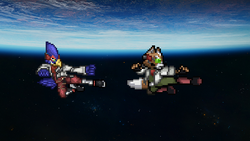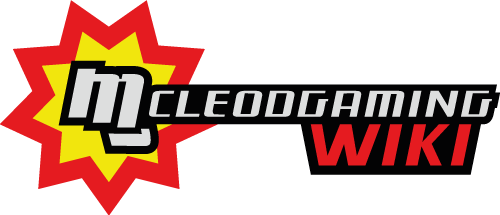
Fox's and Falco's neutral aerials in Super Smash Flash 2, as an example of a clone character.
A clone character is a character that is created by copying another character's files and making adjustments. It is a concept used in many video game series to quickly increase the size of the playable roster. They are far easier to create than a character made from scratch, but in exchange, have many of the same attacks and animations as their source, though their properties may be adjusted to give them an altered gameplay style from the parent. Overall, a clone's status as a clone is usually primarily aesthetic.
Historically, clones have proven to be controversial additions to the roster, both in the official Super Smash Bros. titles and in the Super Smash Flash series, as they are often erroneously perceived to be taking the place of a more unique character. The error lies in that the time and labor required to add a clone is incomparably low compared to that required to create a character from scratch. For example, Pichu was able to be created within a two-month period between the release of Super Smash Flash 2 Beta in late May 2017 and Super Smash Con 2017 in early August to be released in a relatively minor patch, something that would not have been possible with a more independent character.
The term semi-clone is occasionally used for characters such as Luigi that are clearly inspired by another character but have too many significant differences to have been directly copied. However, the line drawn between clone and semi-clone is typically completely arbitrary, and the term has no firmly agreed-upon definition.
In Super Smash Flash[]

|
This section requires to be rewritten or expanded.
The information is not outdated nor incomplete, although it can be rewritten for a more formal explanation and better clarity. It may require an expansion going further on missing details. |
In the original Super Smash Flash, there are four clone characters, all unlocked by beating a single-player mode with their parent characters.
| Clone | Parent | Similarities | Differences |
|---|---|---|---|
| Blade and Blue have very similar attributes and attack properties, and possess a jump attack. Their animations are also visually almost identical. | Blue deals slightly more damage than Blade and has a longer attack length, making him overall better competitively than Blade. However, he moves and attacks at a slightly slower rate, and he has bigger hurtboxes. His side attack has instant-KO properties. His moves tend to have their disjoints at the end of the animation as opposed to the beginning. | ||
| Link and Young Link have very similar attributes, only differing in a few places. All of their attacks are visually similar and do the same knockback type, and most of them do the same amount of damage. | Young Link has a much faster attack rate and moves faster. His hurtboxes are significantly smaller than Link's, as well. However, that also reduces his range on his instant-KO attacks. His Fire Arrows have a longer startup and move slower, but last much longer, covering more distance. His Boomerang comes out slightly slower and is also weaker. His side attack does three slashes instead of two, but functions mostly the same aside from hitbox differences. | ||
| Mario and Luigi have nearly identical attributes. Almost all of their attacks do the same amount of damage, knockback type, and fulfill the same basic function. | Luigi has more range, better combo ability, and longer-lasting attacks. However, Luigi also has bigger hurtboxes and a slower attack rate. His fireballs have a longer startup, move slower, cover less distance, but last much longer than Mario's. His down attack, Green Missile, is aesthetically different than Mario's, while also having a higher damage output, faster travel speed, and longer duration. | ||
| Sonic and Super Sonic have similar attributes, though with several minor changes spread throughout. All of their attacks are visually similar and do the same knockback type. | Super Sonic moves faster, jumps higher, deals more damage, and has longer-lasting attacks. However, he also has smaller hitboxes, taller hurtboxes, and a slower attack rate. His range varies. His side attack does a front kick instead of a spinning side kick, too. |
In Super Smash Flash 2[]

|
This section requires to be rewritten or expanded.
The information is not outdated nor incomplete, although it can be rewritten for a more formal explanation and better clarity. It may require an expansion going further on missing details. |
Clones in Super Smash Flash 2 are more difficult to add than they were in SSF, mainly due to the larger roster and higher-quality sprites. However, they do exist, as a part of the labor of initially creating hitboxes and physics is still saved.
Every character has had a direct file connection to Ichigo, as he was the first character to be programmed. Even with entirely independent characters, copying an existing one is often done first as a template to minimize the possibility of missing animations, bugs, and crashes during the character creation process. For example, Chibi-Robo, when initially shown at APEX 2014, periodically appeared to turn into Samus when the game tried to load animations that had not been made at the time. However, despite this, Chibi-Robo is not a Samus clone, as none of Samus' design remains in Chibi-Robo's final character.
There are no full clones in SSF2, nor are there any clones for characters that have not participated in Super Smash Bros. series. Furthermore, Ganondorf and Pichu have been given many differences that are not present in Smash Bros. series, especially Ganondorf, who is a pseudo-clone (meaning almost a unique character).
| Clone | Parent | Category | Different attacks | Attributes |
|---|---|---|---|---|
| Semi-clone | Falco has a unique neutral attack, up tilt, forward smash, forward aerial, back aerial, up aerial, and Final Smash. | Despite Falco getting his own Final Smash, some of his attacks (including his up tilt) have been reverted to those from Super Smash Bros. Melee, resulting in his neutral aerial and down special move being shared with Fox.
Many of their attacks use the same or similar animations, and they also share the same fast falling speed and high learning effect. Because of these similarities, they are often collectively referred to as "spacies" in the competitive community. Their basic attributes are very different; Fox dashes much faster, Falco jumps much higher, etc. They also have different playstyles due to the different functions and properties of their attacks. Fox is much more of an aggressive rushdown character, while Falco has to play more patiently and is able to take greater advantage of combo opportunities. | ||
| Pseudo-clone | Ganondorf's only similar moves are his back aerial, up aerial, down aerial, pummel, neutral special move, up special move, and down special move. The rest of his moveset is unique. | Ganondorf has a large amount of unique elements added to him that do not exist in the Smash Bros. series. For example, his up tilt varies in strength depending on how long you press the button, his neutral aerial is a move that reflects projectiles in Project M, and his back aerial is a dark magic attack instead of a normal one.
His special moves are still similar to Captain Falcon's, though his up special move has been changed to a multi-hit grab and throw move, while his grounded down special move is based on one of its custom variations from SSB4, respectively. | ||
| Semi-clone | Luigi has a unique third neutral attack, up tilt, down tilt, dash attack, forward smash, down smash, forward aerial, down throw, side special move, and Final Smash. | Their appearance follows that of Brawl, with Luigi having a new down throw from SSB4, and new running animations from Super Smash Bros. Ultimate. However, Mario's moveset is from Melee, so their down aerials and down specials (Mario Tornado and Luigi Cyclone) are the same, respectively.
Compared to Mario, Luigi has a higher jump height, yet a slower ground speed, slower air speed, and lower traction than the former. His Super Jump Punch is drastically different, being a one-hit move with an initial sweetspot compared to Mario's multi-hitting version, in addition to granting no horizontal distance, though this is remedied with his mobility-based side special. Combined with his low traction, Luigi is a slippery, bag-of-tricks character compared to his jack-of-all-trades brother. | ||
| Semi-clone | Pichu has a unique forward tilt, up smash, down smash, back aerial, back throw, neutral special move, and Final Smash. It also has many unique gimmicks, such as recoil damage from electrical attacks. | Unlike Super Smash Bros. series, Pichu has many unique attacks and elements that Pikachu doesn't have. Most notably, Pichu has a new gimmick, Discharge, where Pichu's special moves and forward smash are changed when Pichu accumulates 50% damage. Pichu also has new neutral special move, Electro Ball, which travels much slower and a different angle compared to Pikachu's Thunder Jolt.
It also has many differences in moves shared with Pikachu; forward smash is a multi-hit, down aerial descends fast and meteor smashes, Skull Bash has a different trajectory, and Thunder can also meteor smash. The exception to this is Agility, which, unlike the Super Smash Bros. series, can deal damage like Pikachu's Quick Attack. |
